St Ives Photo Album - 1920 to 1939
This tour of St Ives starts at The Thicket, takes you along Barnes Walk, The Waits, The Broadway, Bridge Street and St Ives bridge, before heading to Market Hill, finishing in St Audrey's Lane.
If you would like to add a photograph to the collection, please click
Get in touch. To view photos in other albums,
click here.
The Thicket and Barnes Walk
 |
| Exiting The Thicket, the damaged Parish Church spire in view, early 1920s. |
 |
| Looking back along The Thicket path, Nobles Field on the left, 1931. |
 |
| Looking back along Barnes Walk, 1931. |
The Waits
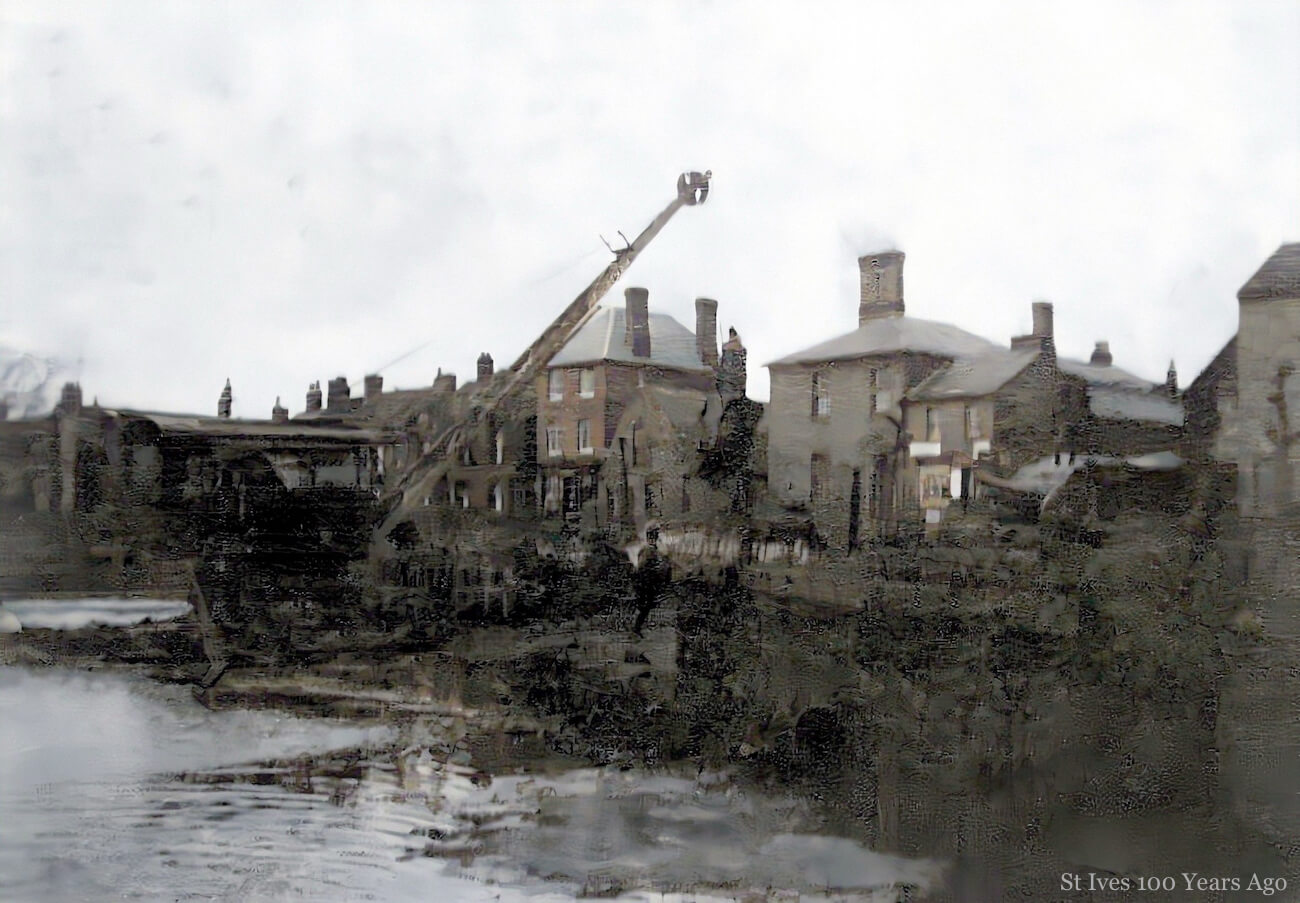 |
| Work to install the WWI war trophy, a German heavy gun on the right, 1921. |
 |
| The installation from another angle, 1921. For current view, click here. |
 |
| German 15cm sFH13 heavy field howitzer, members of the Chapman family in the foreground. |
In January 1919 the Town Council asked the War Office for ‘a suitable war trophy’, asking for two cannons. They received a German 15cm sFH13, a heavy field howitzer. It was one of the most important and common pieces of German artillery, one of hundreds given to English villages and towns after the Germans surrendered their artillery. Capable of firing three shells a minute, it was responsible for an untold number of English deaths and injuries in the trenches.
There was some opposition to displaying such a potent image of WWI. No doubt the widows and mothers of the 74 men whose names had been unveiled on the St Ives War Memorial just a short time before didn’t want such a prominent reminder, particularly of the very gun that might have caused the death of their son or husband. So the trophy remained hidden in a back yard for some time. The Comrades of the Great War, who met regularly in the Constitutional Hall for smoking concerts, applied pressure and the howitzer was given pride of place on the Waits in 1921.
The attraction of these trophies soon began to wane. Ex-soldiers who had survived years of shelling in the trenches didn't appreciate a reminder of the experience in their home town. Parents wondered if it was this very gun that had killed their son. Throughout the country trophies disappeared. Some were dragged into a river or pond. Others never quite made it to the prominent display originally intended. St Ives' war trophy survived until the 1940s, when it was taken for scrap.
 |
| King George V Silver Jubilee celebrations, The Waits, St Ives, 1935. For current view, click here. |
May 1935 marked George V's 25th year on the throne. Throughout the UK towns and villages celebrated this first Silver Jubilee celebration of a British monarch in history. As always, St Ives celebrated in style, the town centre swathed in flags and bunting. The image above shows the formal parade of dignitaries and townspeople along The Waits.
 |
| Timber delivery for Scotneys at The Waits, 1935. |
Scotney's timber construction business was based at the bottom of Ramsey Road, opposite the grammar school. William Scotney started the business in the late 1800s. His son, Tom Scotney, expanded the business after WWI. In the image above wood from Scotney's timber mill is offloaded for transportation the few yards to the factory premises. The business closed in the mid-1970s.
 |
| St Ives Grammar School, 1927. For current view, click here. |
The Broadway
 |
| The Broadway, 1930s. For current view, click here. |
Crown Street
Merryland
 |
| Woolpack Lane, Merryland, 1934. For current view, click here. |
Woolpack Lane is a narrow alley running off Merrylands towards the river. The view above looks up from the river. The slatted upper storey just beyond the gas lamp in the middle of the image is the slaughter house of one of the butcher shops in Bridge Street.
Bridge Street
 |
| Bridge Street and the last image of the clock tower, 1922. For current view, click here. |
 |
| Dismantling of the clock tower, Bridge Street, 1922. For current view, click here. |
The clock tower was erected in 1802. It's a testament to the original quality of work that the weight was supported for over a hundred years. The image above shows the clock tower being taken down in August 1922 after it became unsafe. Positioned above Kiddle's furniture showroom, Edward Kiddle is shown standing in front of his shop.
 |
| Bridge Street, late 1920s. For current view, click here. |
St Ives bridge
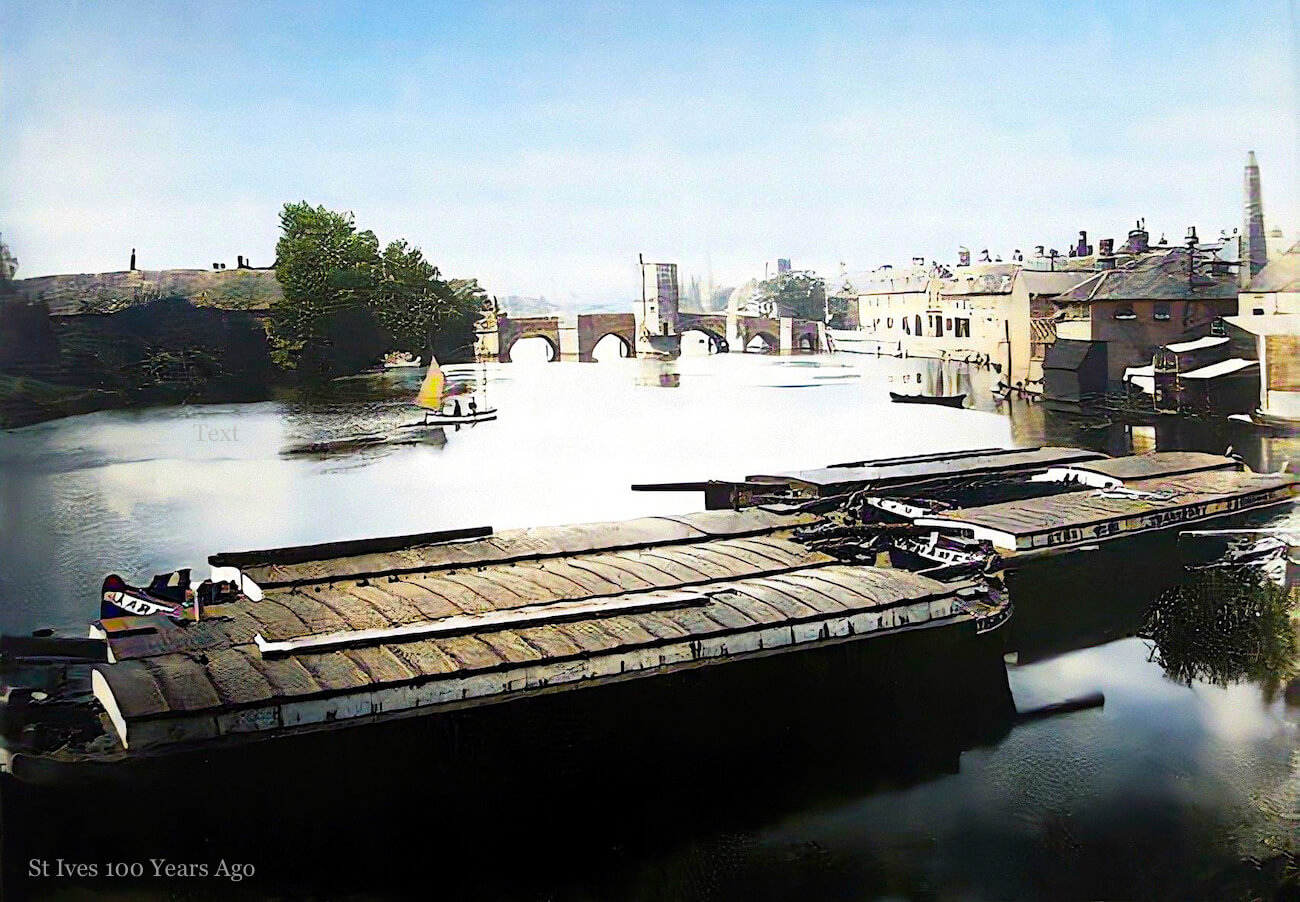 |
| Ouse Transport Company lighters moored off the repair depot, 1930. |
 |
| St Ives bridge and chapel shortly before alteration, 1930. |
 |
| The top two stories of the chapel being removed, 1930. For current view, click here. |
The bridge chapel, one of only four in the UK, was built in 1426 with a ground floor and basement. Two extra stories were added in 1736. In addition to its use as a chapel, it was a pub called Little Hell in the mid-1800s. The extra floors became unsafe and were removed in 1930. At that time the chapel was occupied by the tollkeeper and his family.
 |
| The Cambridge Albion Angling Society, 1936. |
The Cambridge Albion Society was a children's fishing club. In 1936 they held their annual competition in St Ives for 700 members. The children cast their lines into the River Great Ouse from Hemingford Meadow riverbank. Tea was provided in the Corn Exchange, where 93 prizes were awarded.
Filberts Walk
 |
| Filbert's Walk, 1920s. For current view, click here. |
 |
| Filbert's Walk, 1930s. |
Head away from the town centre over St Ives bridge and along London Road. Just over 100 yards beyond The Dolphin car park turn into the footpath on your right. You've reached Filbert's Walk. The route turns left after 75 yards and continues for almost 400 yards to Hemingford Road, with pleasant views over fields, ending in a wooded area. Quite different from that shown in the images above. Families of up to ten members lived in houses with three rooms, one a cellar scullery that flooded most winters. You can read more at the article about
Filberts Walk.
The Quay
 |
| The Quay, 1930s. |
Market Hill
 |
| St Ives Cross of Sacrifice War Memorial unveiled, 1920. For current view, click here. |
 |
| Another view of the ceremony to unveil the St Ives Cross of Sacrifice War Memorial, 1920. |
 |
| Families of the fallen gather around the Cross of Sacrifice, 1920. |
There was a desire to honour those who had sacrificed their lives in WWI with an appropriate memorial. Commissioned to come up with a design for use in Commonwealth cemeteries in France and elsewhere, Sir Reginald Blomfield's Cross of Sacrifice was an elongated cross with a bronze longsword on the front, pointing downwards. It was adopted in town and city throughout the country.
In St Ives the proposed War Memorial caused some lively correspondence in the Hunts Post. Some disapproved of the image of a cross. Others disagreed with the location. Sir Reginald Blomfield visited St Ives to approve the location. It was suggested the funds raised would be used better to restore the Parish Church spire and bells. To read articles and correspondence about the War Memorial,
click here.
A list was displayed in the Corn Exchange detailing names of the men who were to be named on the Memorial. Residents were asked to check the details were correct. What mixture of pride and heartache that list must have generated in the town! The last image above is particularly poignant, showing widows and orphans of men named on the Memorial. To read how St Ives fared through WWI and to learn about the lives of all St Ives men who died in WWI,
click here.
 |
| Sheep market, Market Hill, 1920s. |
 |
| Sheep Market, Market Hill, 1920s. |
 |
| Sheep Market, Market Hill, 1931. For current view, click here. |
St Ives Monday livestock market continued into the 1900s, the cattle market operating until 1976. The images above are of the sheep market, held in the same location for centuries, the area of Market Hill named the Sheep Market.
 |
| Market Hill, early 1920s. For current view, click here. |
 |
| Market Hill, late 1920s. For current view, click here. |
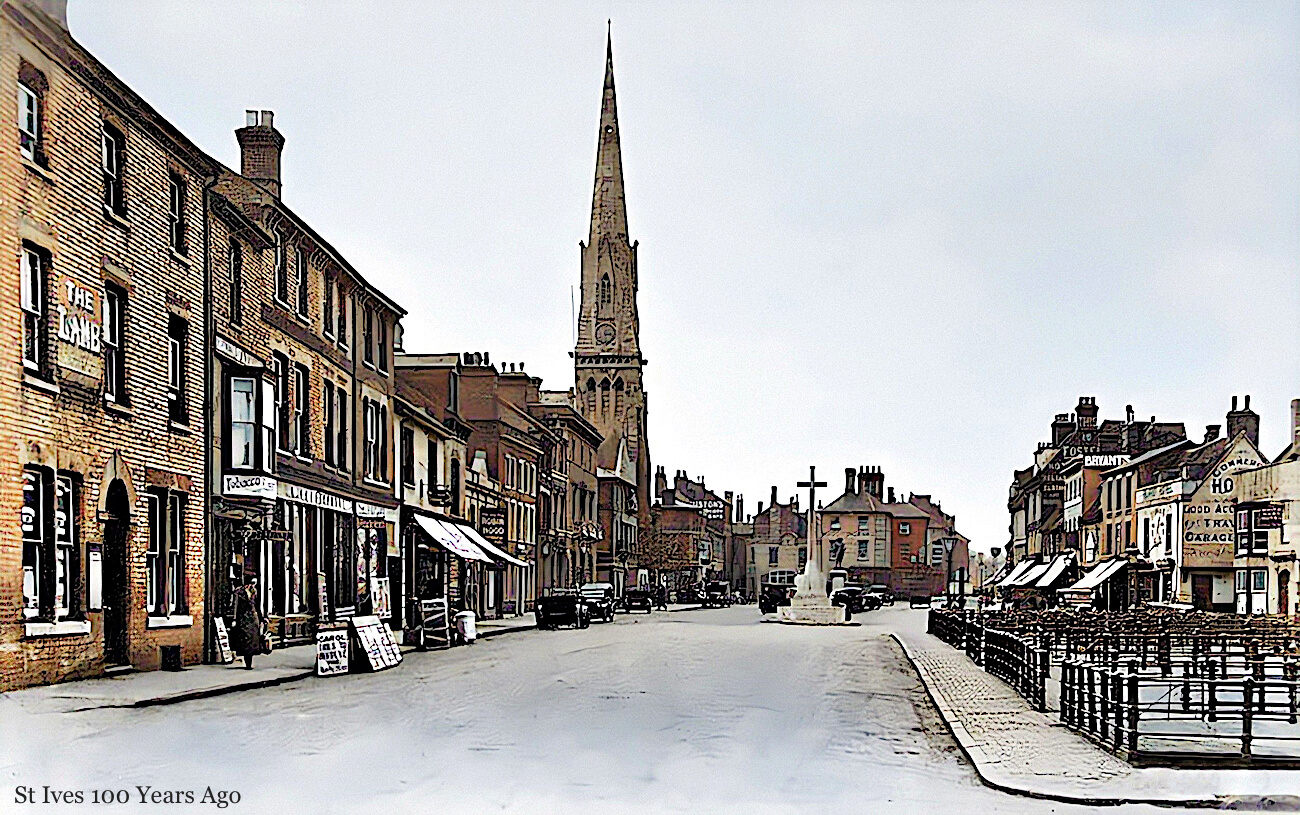 |
| Market Hill, late 1920s. For current view, click here. |
 |
| Market Hill, late 1920s. For current view, click here. |
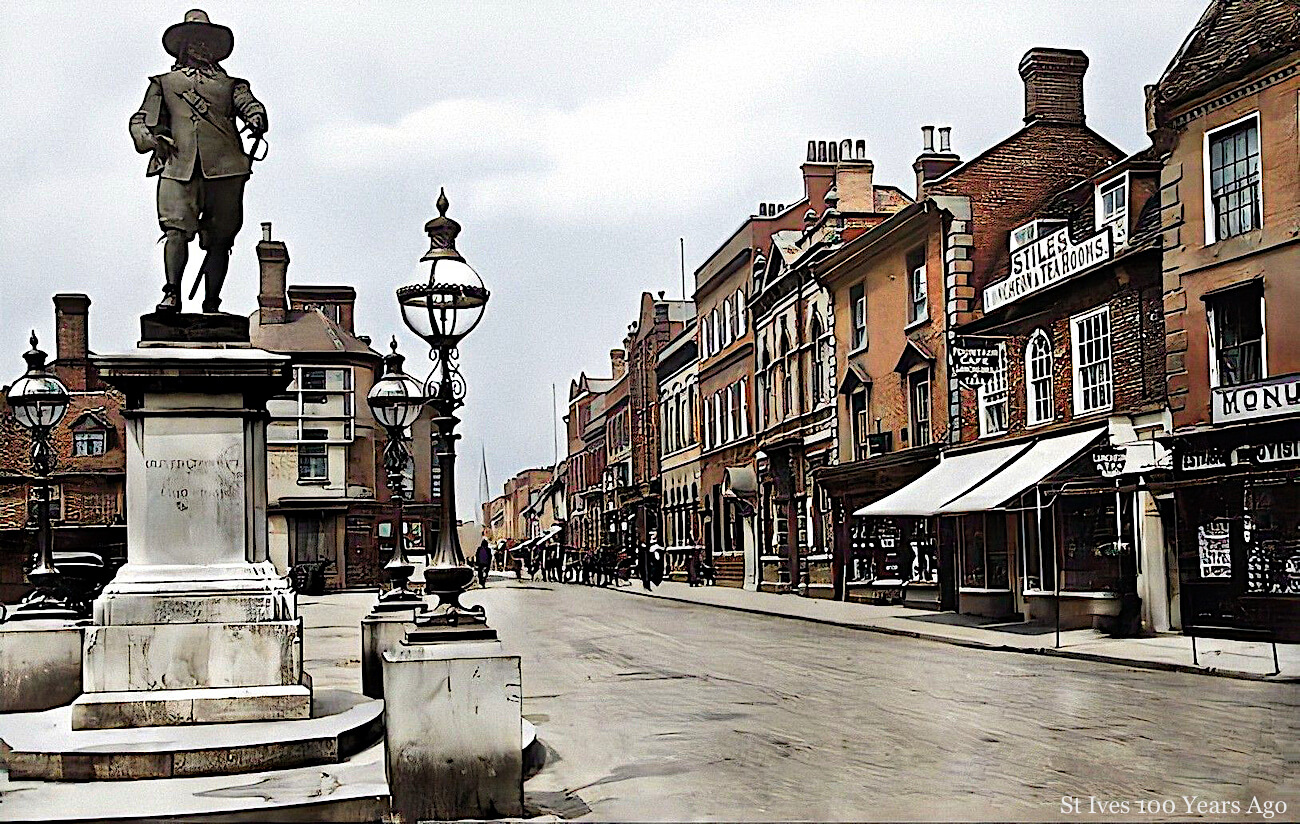 |
| Market Hill, early 1930s. For current view, click here. |
In the above photo on the right is the Fountain Cafe. Originally The Fountain, the Stiles family of bakers took over the premises when the inn closed in 1909, renaming it the Fountain Cafe. The baking connection continues without a break for more than 100 years. Today the premises are occupied by Greggs the bakers.
St Audrey Lane
 |
| Cromwell's barn, 1931. |
 |
| Cromwell's barn, 1931. |
Oliver Cromwell was reputed to have lived for a period at Wood Farm, possibly the same location as Green End Farm. He was supposed to have drilled his troops in the barn that stood just beyond the junction of Ramsey Road and St Audrey Lane. The barn probably dated from the 1500s. Although in good condition and protected by a conservation order, it was demolished in 1964.
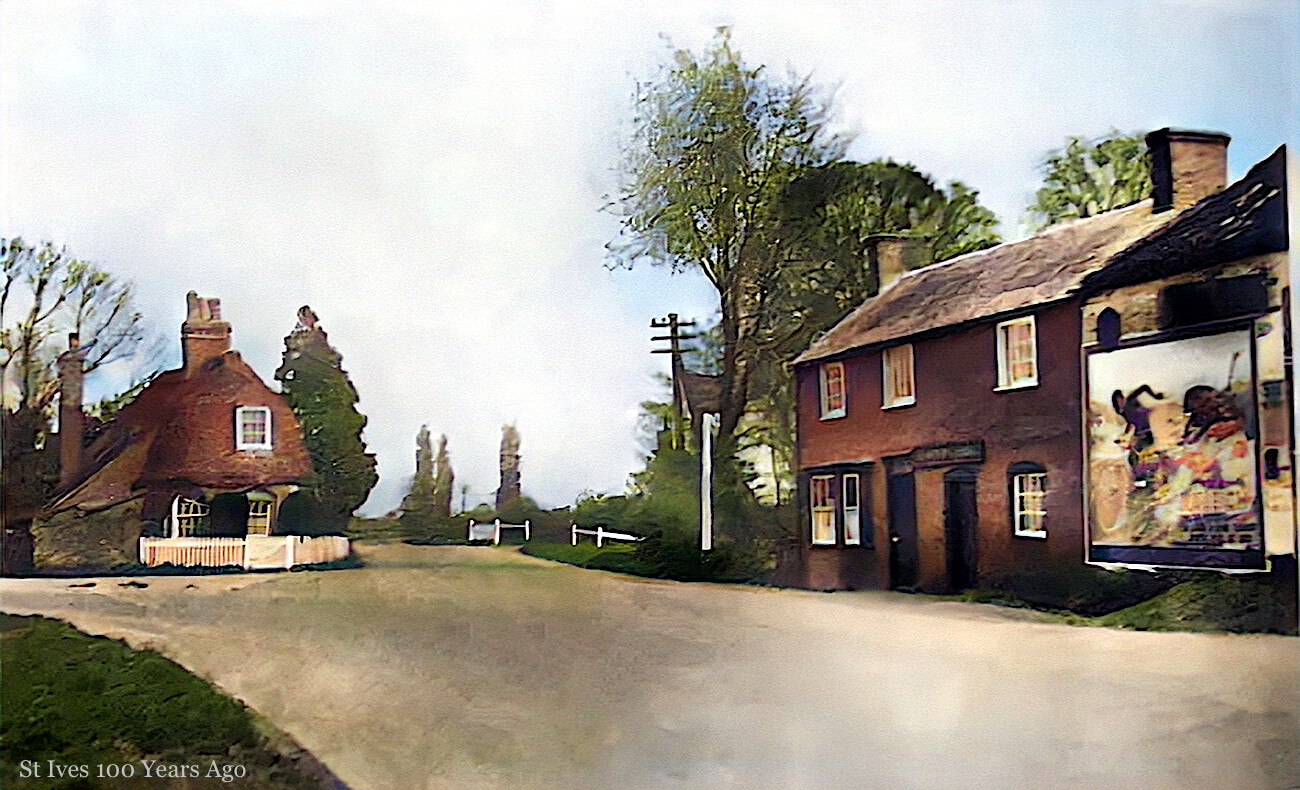 |
| Manchester Arms pub and Republic Cottage, 1920s. For current view, click here. |
 |
| Republic Cottage, 1930s |
Originally a toll house on the St Ives to Somersham turnpike, Republic Cottage was named by owner Henry How in the 1880s because he opposed the monarchy and favoured a republic. The cottage was demolished in 1968 to make way for road widening and is today a very busy roundabout.
Low Road
 |
| Windmill on Low Road towards Fenstanton, 1925. |
It's hard to imagine how regular a feature large windmills such as the one above were in the landscape around St Ives. This was one is a
post mill, designed for the entire structure to be turned to face the oncoming wind.
Windmills could be dangerous. In 1799, the
Ipswich Journal reported on the death of William Fuller's wife. As she was walking from Fenstanton to St Ives market a sudden downpour caused her to take shelter in one of the three windmills along the Low Road, possibly the one shown above. As the rain eased she came out of the windmill and a sail struck her on the head, killing her instantly. She left behind five children.
Aerial views of St Ives
 |
| View of the Parish Church and bathing place, c1920s. |
















































No comments:
Post a Comment